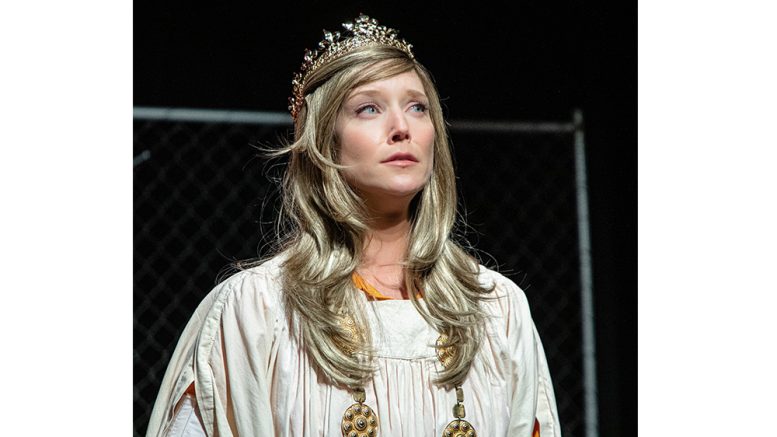By JON LINDLEY
A Seat on the Aisle
It may be one of Shakespeare’s most meta speeches, I’m not sure. But when Richard II appeals to his comrades, “For God’s sake, let us sit upon the ground and tell sad stories of the death of kings,” is it any wonder if we, as knowing audience members, can hardly decide whether to laugh or gasp in recognition of the dramatic irony. We know how events will unfold: his own end is the story being told.
I won’t try to detail the intricacies of Shakespeare’s plot – the political intrigues, the twists and turns that bring Richard to his fate and propel his cousin Bolingbroke to power. But I can vouch that the production of Richard II mounted for (and, apparently, by) Bard Fest, as seen on its opening weekend, is a worthy rendition of this seldom-performed Shakespeare history play, and that’s thanks largely to the deep commitment and spirited performances of its talented cast.
Their love for the language is apparent. In Afton Shepard’s portrayal of King Richard, we’re treated to language as revelation of a precariously poised mind. In Rayanna Gibbs’ Bolingbroke, we hear the steady surety of her well-chosen words and feel the steadiness of her climb to power in the process. While both actors superbly conveyed the music of the language in equal measure, they still managed to reveal character through contrast – the brittle king who poeticizes his problems vs. the contender who minces no words and wields them rather like the weapons to which he’s more accustomed. And in some of the production’s finer moments, the two are together onstage, where we delight in the interplay between the two and the verbal manifestations that drive their actions and their respective fates. It’s Richard, of course, who observes in his poetic way that the golden crown he so loves is now “like a deep well” and how he and Bolingbroke are two buckets, one filling and one emptying.
But this is a Shakespeare history play, after all, so there are far more players to keep track of in the political machinations that surround the two main characters. Standouts for me were Damick Lalioff who provided touchingly heartfelt moments as the Duke of York, Nan Macy in some scene-stealing moments as John of Gaunt and the Duchess of York, and Evangiline Bouw, as Aumerle, for her delicate portrayal of the intriguing complexities of loyalty in this bandying-for-power story.
You may be noticing that I haven’t yet made an issue of the gender swap of this particular production, as presented by its all-female cast. That’s because I found it to be a non-issue. Or rather, I should say, if there was anything notable about it, the all-female cast simply reinforced that these struggles of power, political allegiance, loyalty, and the like are not the sole domain of men but of human beings. The fact that director, Glenn Dobbs, chose to set the production in a women’s prison was an interesting novelty. And fitting enough, given the state of tension and bellicosity that dominates the play. But as a directorial choice, I wondered if it was one made to somehow justify having only women onstage. If so, I’m not sure I needed it. The play works with women in these roles (pronoun predicaments notwithstanding). But at the same time, that’s not to say I minded the nontraditional setting. The director made clear in his notes that this was an experiment. And I’m all for that. As an experiment, it was engaging, it was appropriate for the piece, and it presented us with some creative prop choices – cigarette packs hurled down as flung gauntlets, toothbrush shivs for rapiers…
If I had a quibble to make about the staging, though, it was with the stage combat. I know it’s a challenge for a fight choreographer in live theatre to walk the fine line of verisimilitude – allowing us to believe blows are landing while also being reassured that actors are not being injured. But some of the initial punches in the fights I witnessed were so cautiously thrown, so wide of the mark, I had a hard time suspending my disbelief – or even realizing it was a fight that was breaking out, as opposed to, say, an embrace. It may seem like a small detail, but sometimes, a hit must at least seem to be a palpable hit.
But overall, the fights were otherwise well-executed and reinforced the conflicts essential to the story. And this telling of this story was still a hit with me in the end.
Richard II continues through Oct. 30 at the Indy 11 Theatre at the Indy Fringe building, 719 E. St. Clair St., Get your tickets at indybardfest.com/richard-ii-at-indy-11.
Read more great play reviews from A Seat on the Aisle at asota.wordpress.com.

